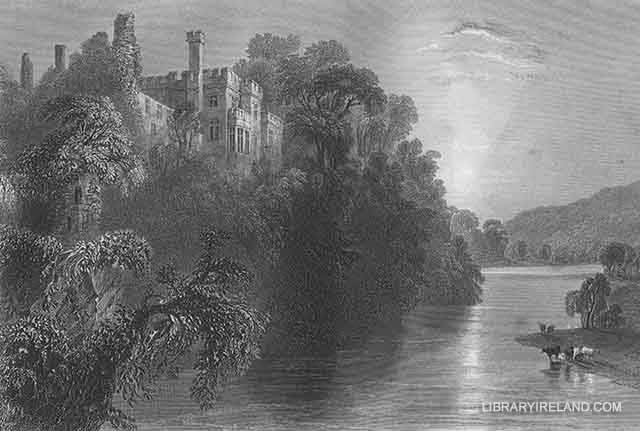Lismore Castle, County Waterford
The views of LISMORE CASTLE, which have always been taken from the most favourable points, prepare a disappointment for the traveller who chances to approach it first from the side toward the town, the insignificant buildings of which shoulder it rather too closely. From all other points, however, it is a most striking and noble object, and justifies its reputation as one of the first of the noble residences and demesnes of Ireland. Its position, overhanging the Blackwater, is very commanding; its gardens, lawns, and walks are laid out with exquisite taste; its antique towers and its modern habitableness are beautifully harmonised; indeed, it is a spot which one's heart aches to leave—capable, to the imagination at least, of all that a residence can do for the happiness of the most luxurious. This castle was the property of Sir Walter Raleigh, at whose death it was forfeited, and purchased by the ancestor of the Duke of Devonshire. The town of Lismore adds to this historic interest the fact that it was the birthplace of Boyle and Congreve.
"Lismore Castle," says Ritchie, "was founded on the ruins of an abbey by King John, in the year 1185. After being destroyed by the Irish, and undergoing various other fortunes, it was rebuilt, and became an episcopal residence; till at length, in 1589, it passed with the rest of the manor to Sir Walter Raleigh, on consideration of a yearly rent of £13 6s. 8d., and was afterwards sold by him to the Earl of Cork. In 1626, the famous Robert Boyle was born within its walls. In the rebellion of 1641, it withstood successfully a siege by five thousand Irish, under Sir Richard Beling.
"Two years after, the castle was attacked again by a still greater force, and again remained triumphant; but in 1645, it was at length taken by Lord Castlehaven. The defenders on this occasion were Major Power, and a hundred of the earl's tenants, who are said to have been allowed honourable terms of capitulation, after expending all their powder, and killing five hundred of the enemy. This sounds like one of Napoleon's bulletins.
"From the Boyle family Lismore passed into that of Cavendish in 1748, by the marriage of Lady Charlotte Boyle, daughter of the fourth Earl of Cork, to the fourth Duke of Devonshire. The present duke has done much to improve and beautify the place, but what is of still more consequence, he is said to be the best of the very few good landlords in Ireland.
"This fortress covered originally a considerable space of ground, as may be seen by the walls and towers still remaining. Between the boundaries, however, and the castle there is now one of the most charming promenades in the world, a little paradise of walks, and plants, and trees. The path leads in some places to the very brink of the precipice which overhangs the Blackwater, whence a view is commanded of the deep vale below, and the eye carried along numerous vistas opening among the mountains beyond. I left the path, scrambled for some distance along the precipice, and returned another way, my mind filled with more pictures, each altogether distinct from the rest, than a week's walk could have procured me almost anywhere else.
"The principal buildings of the castle surround a large square, and are furnished with modern doors and windows, with more attention to comfort than to good taste. The square, notwithstanding, has a gloomy appearance. I passed in unquestioned. Not a human being was visible, and even the sound of the wind among the trees was no more when I entered the deserted area. At that moment there stepped gravely up to me a large eagle; and I could not help starting back and eyeing him respectfully, as 'one having authority.' He contented himself, however, with an attentive examination of my appearance, and I strolled on."

